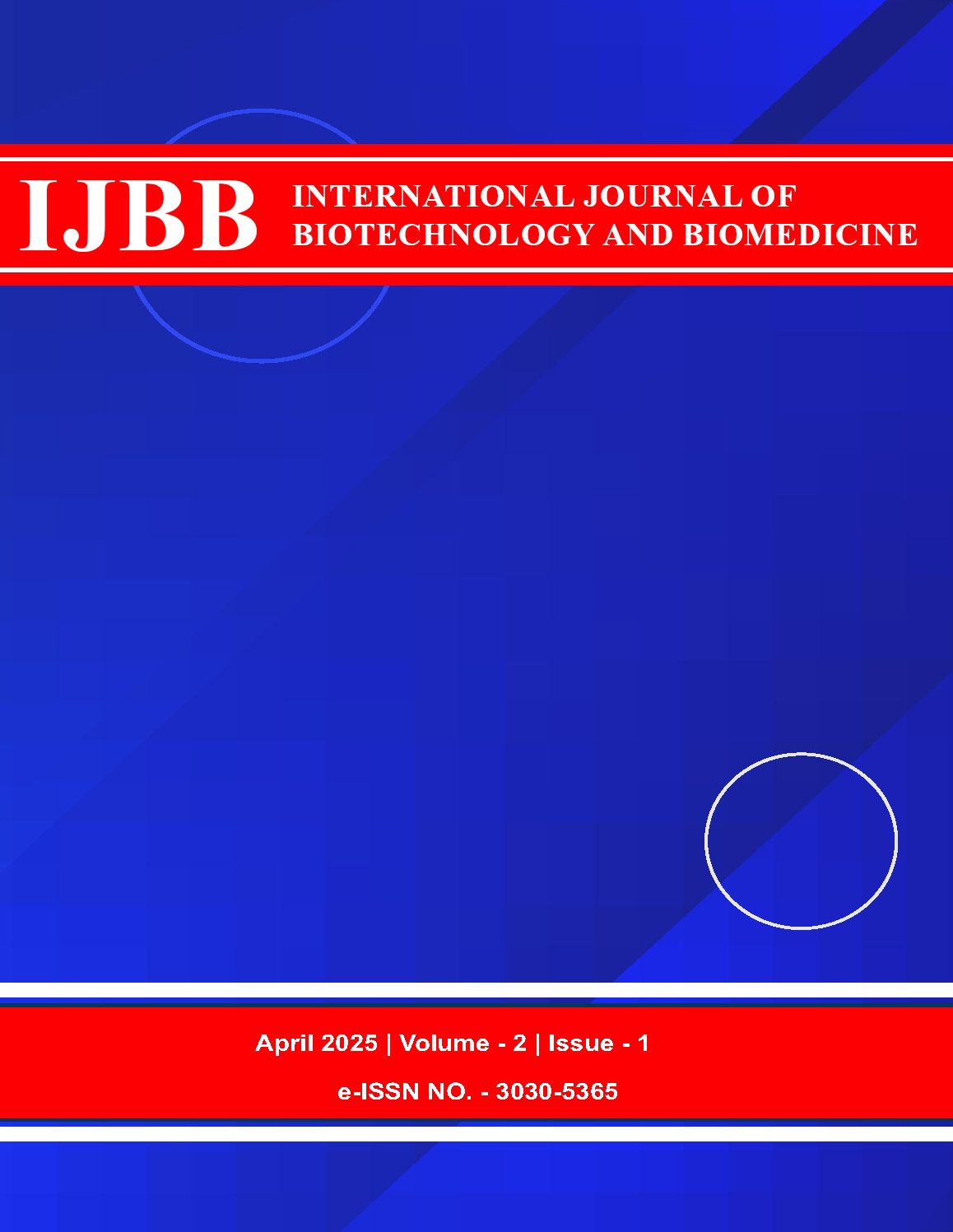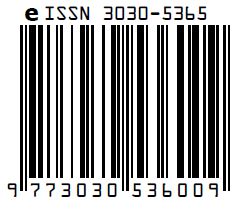Extraction of Chinese Green Tea and its Toxicological Evaluation
DOI:
https://doi.org/10.31674/ijbb.2025.v02i01.005Abstract
Green tea extract has numerous health benefits along with anticancer activity due to the presence of powerful antioxidants, but there are some controversial adverse effects, in the case of long-term treatment as well as dose dependent. This study focused on the identification and content of bioactive components of Chinese green tea extract and investigated their toxicological effect on the pathological and histological of rats. The study was designed for an acute dose of 2000 mg/kg green tea extract for seven days. Sub-acute doses of 300 mg/kg, 500 mg/kg, and 1000 mg /Kg for 28 male and female BN rats. Results demonstrated that all rats were alive, and biochemical parameters met the reference values. Slight histopathological changes were observed in the liver at a dose of 1000 mg/kg. These findings suggest that the loading dose did not affect the vital organs of the rats or their survival rate. This Chinese green tea extract can be used to achieve the expected therapeutic benefits without any adverse effects.
Keywords:
Green tea extract, Extraction, Toxicology, Liver Injury, Adverse effectReferences
Abubakar, M., Chen, J., & Ma, X. (2019). Toxicological perspective of green tea catechins and polyphenols: A review. Critical Reviews in Food Science and Nutrition, 59(4), 487–501.
Ahmad, N., Fazal, H., Abbasi, B. H., & Khan, M. A. (2022). Profiling and quantification of polyphenolic compounds in Camellia sinensis using reversed-phase HPLC. Molecules, 27(10), 3130.
Alshammari, F., Alqahtani, A., Alshahrani, M. Y., & Alyousef, A. A. (2023). Histopathological and biochemical evaluation of the protective role of natural antioxidants against drug-induced organ toxicity in rats. Toxicology Reports, 10, 45–55.
Ameer, K., Shahbaz, H. M., & Kwon, J. H. (2022). Green extraction technologies for polyphenols from green tea: Recent trends and future prospects. Trends in Food Science & Technology, 120, 284–296.
Chen, J., Liu, S., & Zhang, T. (2023). Caffeine in green tea: Pharmacological effects and potential health applications. Nutrients, 15(3), 678.
Chen, M., Yang, Q., & Zhao, F. (2023). EGCG modulates inflammation in allergy-related diseases via TLR4/NF-κB and Nrf2 signaling pathways. International Immunopharmacology, 115, 109645.
Chen, Y., Liu, J., Zhang, R., Wang, T., & Zhou, X. (2023). Acute and subacute oral toxicity evaluation of green tea extract in rodents: A study following OECD guidelines. Journal of Ethnopharmacology, 312, 116504.
Chen, Y., Zhao, Z., Li, J., & Wang, C. (2023). Mechanistic insights into the metal-chelating and antioxidant activities of EGCG: A computational and experimental study. Antioxidants, 12(4), 745.
EFSA Panel on Nutrition, Novel Foods and Food Allergens (NDA). (2022). Safety of green tea catechins: updated assessment. EFSA Journal, 20(3), e07083.
Feng, R., Lu, Y., & Bowman, L. (2021). A comprehensive toxicological review of green tea extracts: Risk-benefit perspective for human health. Food and Chemical Toxicology, 152, 112173.
Hu, J., Zhang, Y., Wang, L., & Zeng, L. (2020). Hepatotoxicity of high-dose EGCG in animal models and humans: A review. Food and Chemical Toxicology, 138, 111190.
Huang, Y., Wang, X., Xu, M., & Yang, Y. (2021). Epigallocatechin-3-gallate (EGCG) in oxidative stress regulation and chronic disease prevention. Journal of Functional Foods, 87, 104732.
Kawada, N., Kawaguchi, T., & Kobayashi, H. (2020). Safety assessment of green tea extract in clinical settings: Focus on hepatotoxicity. Regulatory Toxicology and Pharmacology, 115, 104698.
Khan, N., & Mukhtar, H. (2023). Green tea polyphenols in prevention of cancer and age-related diseases: Current evidence and future perspectives. Food & Function, 14(2), 1180–1195.
Kim, J. H., Lee, H. S., & Lee, J. H. (2020). Safety assessment of green tea extract in rodents. Toxicological Research, 36(1), 41–49.
Kim, S. J., Lee, K. H., & Park, H. J. (2019). Effects of harvesting and storage conditions on green tea quality and catechin stability. Food Chemistry, 277, 1–7.
Lee, J. H., Kim, H., & Park, C. (2023). Toxicological evaluation of green tea extract: Insights into safe dosage and potential risks. Toxicology Reports, 10, 1254–1261.
Lee, S. Y., Park, J., & Kim, Y. (2023). EGCG in cancer prevention and therapy: Molecular mechanisms and clinical potential. Pharmacological Research, 191, 106747.
Li, H., Wang, Y., Zhang, L., Chen, X., & Zhao, J. (2023). Subchronic oral toxicity evaluation of green tea extract in rodents: Hematological, biochemical, and histopathological findings. Regulatory Toxicology and Pharmacology, 139, 105336.
Li, X., Wang, L., & Zhang, Y. (2021). Bioactive compounds and health benefits of green tea: A comprehensive review. Food Science & Nutrition, 9(2), 1166–1178.
Li, X., Wu, D., & Chen, X. (2023). Toxicological evaluation of standardized green tea extract in Wistar rats. Regulatory Toxicology and Pharmacology, 139, 105295.
Liu, J., Zhang, Y., Wang, T., & Chen, L. (2023). Quantitative analysis of catechins and caffeine in green tea extracts using HPLC with UV detection. Journal of Food Science and Technology, 60(4), 1278–1286.
Sampaio, G. R., Soares, R. A. M., & Bastos, D. H. M. (2020). Green tea: Technology, functionality, and toxicology of extracts and catechins. Food Research International, 137, 109682.
Sharma, R., Singh, A., & Taneja, V. (2021). Subchronic toxicity of green tea extract: A histopathological perspective. Journal of Medicinal Plants Research, 15(4), 87–93.
Tavares, L., Santos, M., & Oliveira, R. (2022). Hydroethanolic extraction optimization and antioxidant activity of Camellia sinensis leaves. Journal of Food Science and Technology, 59(1), 211–220.
Wang, L., Zhang, H., & Liu, B. (2024). EGCG attenuates allergic airway inflammation by suppressing Th2 responses and cytokine production. Frontiers in Pharmacology, 15, 1212231
Wang, R., Zhou, W., & Jiang, X. (2022). Recent advances in tea polyphenol chemistry and bioactivity. Critical Reviews in Food Science and Nutrition, 62(20), 5610–5625.
Wang, S., Liu, H., & Zhou, Y. (2023). Toxicological and biochemical assessment of green tea polyphenol extract in rats. Food Research International, 163, 112213.
Wang, T., Xu, Q., & Li, J. (2024). Epigallocatechin-3-gallate as a modulator of cellular signaling: Recent advances and therapeutic implications. Biomedicine & Pharmacotherapy, 174, 114043.
Wang, Y., Li, X., & Zhang, Z. (2023). Evaluation of chronic toxicity and drug interactions of high-dose green tea extract in animal models. Journal of Ethnopharmacology, 309, 116339.
Zhang, J., & Wei, Y. (2023). Post-harvest factors affecting green tea composition and bioactivity: A mini-review. Trends in Food Science & Technology, 139, 93–99
Zhang, L., Chen, W., Li, Y., & Huang, J. (2023). Subacute oral toxicity evaluation of botanical extracts in Wistar rats following OECD guidelines. Regulatory Toxicology and Pharmacology, 140, 105338.
Zhang, L., Li, Y., Liu, X., & Wu, Y. (2022). Green tea catechins in metabolic syndrome: Current status and future perspectives. Nutrition & Metabolism, 19(1), 10.
Zhang, M., He, Y., & Li, J. (2021). Comparison of extraction techniques for catechins from green tea leaves and their impact on antioxidant activity. Molecules, 26(3), 611.
Zhang, X., Chen, W., & Zhao, L. (2020). Comprehensive analysis of phenolic compounds in green tea and their antioxidant properties. Journal of Agricultural and Food Chemistry, 68(15), 4212–4220.
Zhang, Y., Chen, H., & Li, Q. (2022). Protective effects of EGCG in cardiovascular and neurodegenerative diseases: A review of mechanisms. Nutrients, 14(7), 1420.
Zhou, Y., Fan, Y., & Wang, M. (2021). Advances in extraction technologies for bioactive compounds from green tea: A review. Journal of Food Science and Technology, 58(7), 2582–2591.
Zhou, Y., Zhang, Y., Wang, L., Wang, J., Wang, Q., & Sun, Y. (2021). Toxicological evaluation and subchronic effects of a plant-derived compound in Wistar rats. Regulatory Toxicology and Pharmacology, 121, 104877.





